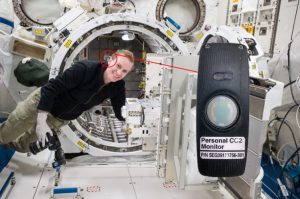By Siobhan Molloy, SST Sensing & Rachael Barton, GSS
Within a self-contained system where humans are respiring, there will be a build up toxic CO2 levels over time. As a consequence, in any form of spacecraft where humans are present, effective mechanisms for removing CO2 and resupplying oxygen need to be implemented. However, operational necessities still dictate that these will only be efficient enough to keep the CO2 levels down to a certain extent.
As air moves differently in such locations, without the influence of gravity involved. Heat does not rise and this in turn leads to significantly less mixing of air taking place. The occupants onboard the International Space Station (ISS) are thus exposed to greater levels of CO2 during their time onboard than the rest of us experience. Down here on Earth it represents just 0.03% of the air’s content (equating to a partial pressure of 0.23 mmHg). NASA has set a long-duration spacecraft maximum allowable CO2 concentration that is more than double that figure, at 0.7% (a partial pressure of 5.3mmHg).
Though extensive terrestrial studies have shown that this increased level will have no effect on the continued good health of those exposed to it, there must be some acknowledgement of the fact that crew members onboard the ISS still regularly experience symptoms of acute CO2 toxicity – such as headaches or lethargy.
It is generally accepted that human adaptations to microgravity conditions will cause astronauts in space to become more sensitive to elevated CO2 levels. This can result not only in physical discomfort, but also impinge on their cognitive skills and reaction times – thereby potentially leading to safety risks. On average crew members stay on the ISS for a period of around 6 months, so having a good grasp of the ongoing implications is clearly of great value.
With operational practicalities meaning that it is not possible (either technically or financially speaking) to remove enough CO2 to replicate normal conditions here on Earth, the ISS has to function with relatively high ambient CO2 concentrations present in the air. Yet its occupants have to live and work in an acceptable environment.
NASA scientists have, for many years, wanted to embark on a thorough investigation of how elevated CO2 levels impact on ISS crew members’ ability to carry out their allotted tasks, but it has taken a long time for them to be in a position to employ a method for acquiring data to a high enough degree of precision. Given that, as already mentioned, air does not mix well without the influence of gravity, wall-mounted sensors had proved themselves to be an unsuitable means by which to get an accurate reflection of a crew member’s exposure to CO2. What was needed instead were wearable CO2 sensors.
There were several key criteria that a wearable CO2 sensor would have to meet. These were as follows:
- It would need to support a prolonged battery life – so that operation could be sustained for an extensive period without recharging being required.
- For wearer comfort and convenience, the sensor would have to be compact and have a low mass.
- A simple data interface would also be important, so as to make the information acquired easy to access, while at the same time keeping the system development process as short and uncomplicated as possible.
After a comprehensive survey of what products were on the market, the scientists working in NASA’s Technology Transfer Program decided on the best option. A solution from Scottish sensor manufacturer SST Sensing Ltd developed with its long-established engineering partner Gas Sensing Solutions (GSS) was specified accordingly. The two companies liaised with NASA during the prototyping phase, providing detailed performance information on the industry-leading CozIR CO2 sensor so that this device could be used with maximum effectiveness in space agency’s personal CO2 monitors.
Once they had been supplied, the NASA team charged with execution of the project then constructed a custom-designed baseboard around each CozIR sensor. This hardware provided all the necessary power regulation, processing, data storage and wireless connectivity. The team also designed a housing that could be 3D printed and easily clipped on to crew member’s clothing (with the sensors being worn on the back of their collars).
Thanks to the highly advanced optoelectronics employed by the CozIR gas sensors, these low power, high speed non-dispersive infra-red (NDIR) devices can cover measurements down to ppm CO2 levels (with a range of 0 to 5000ppm and a ±5% sensor accuracy). They comfortably support an operational lifespan of 10 years. Pivotal to their suitability for this application was their power saving capabilities – with devices just drawing 3.5mW at 2 samples/sec acquisition rates. This means that they are 50 times less power hungry than standard NDIR sensor options currently on the market. Another advantage was the ease of connectivity – with a convenient serial connection facilitating data transfer.
Through these personal CO2 monitors, it will be possible for simple and unobtrusive tracking of the astronauts’ individual CO2 exposure to be undertaken over an extended period of time. Astronauts will be able to view their own data straight away via a custom iPad app. Furthermore, all the datasets obtained from crew members will subsequently be compiled together and utilized by researchers to get a better understanding of the long-term effect of heightened CO2 exposure during space travel. Not only could this prove highly beneficial to the ISS crew, but also for potential future missions to Mars.
The personal CO2 monitors that were developed for this project were transported to the ISS back in the spring, with the crew completing proof-of-concept demonstrations soon after. The process of gathering data is now underway, with initial analysis due to take place towards the end of the year.

Contact SST Sensing Ltd
Siobhan Molloy
Marketing Executive
5 Hagmill Crescent,
Shawhead Industrial Estate,
Coatbridge, Scotland, ML5 4NS
Tel: +44 (0) 1236 459020
Email: smolloy@sstsensing.com

